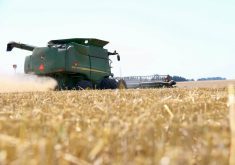Western Canadian feeder cattle prices were steady to $3 higher last week while U.S. prices jumped $4 to $8. Auction market volumes were extremely light while most cattle buyers started their holiday season.
It’s that time of year when quality feeder cattle are hard to find and feedlot owners have other issues to contend with. A small group of 660-pound steers sold for $130 per hundredweight (cwt) in central Alberta but by the end of the week, these same cattle would have been $5/cwt higher. April 2012 live cattle futures had to retest contract highs before feedlot managers realized this may be a positive opportunity. Alberta packers were paying $102 for fed steers last week but with break-even prices on those pricey spring replacements above $105, most cattle feeders are content to see how the market develops over time.
Read Also

U.S. grains: Soybeans hit six-week low as Brazilian harvest looms; corn, wheat sag
Chicago | Reuters – Chicago soybean futures fell to six-week lows on Friday as worries about slowing export demand for…
Chicago feeder cattle futures are factoring in a risk premium due to the uncertainty in fall supplies. I mentioned earlier that U.S. feedlot placements have been running above year-ago levels and the market may experience a vacuum of demand from September through December. This buying interest from south of the border would be further enhanced if the moisture situation in the U.S. southern Plains improves. The fundamental structure is gearing up for larger Canadian feeder cattle exports in the final quarter of 2011.
U.S. consumer spending during May dipped to 20-month lows and beef demand in the latter half of the year is extremely vulnerable. Chronic unemployment and historical high gas prices are tempering beef demand. Average U.S. and Canadian consumers are struggling to make ends meet as disposable income contracts.
October feeder cattle futures are near historical highs. Cow-calf producers should look at taking some protection that limits the downside but leaves the upside open. This is a very good opportunity in case the U.S. economy slips into another recession.
— Jerry Klassen is a commodity market analyst in Winnipeg and maintains an interest in the family feedlot in southern Alberta. He writes an in-depth biweekly commentary, Canadian Feedlot and Cattle Market Analysis, for feedlot operators in Canada. He can be reached by email at [email protected] or at 204-287-8268 for questions or comments.















